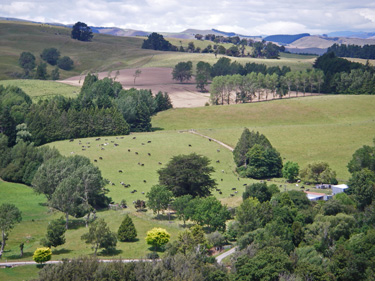The value of trees for shelter and shade
Protection from the extremes of weather is a primary need for humans – and for animals and plants. Constant exposure to strong wind and sun is detrimental to the health and well-being of people, stock and crops.
Despite having a mild climate, New Zealand is windy compared with many countries, as it sits in the westerly airstream of the latitude 40’s and is surrounded by ocean. Farm animals are grazed openly on pasture all year leaving them vulnerable to severe weather events.
During European settlement, much of the native bush was cleared for conversion to pasture and only remnants of bush or individual trees remained. One of the earliest forms of shelter was gorse planted as hedges. However, the gorse became a weed, and hedges needed constant maintenance. During the mid 20th century they were largely removed and replaced with post-and-wire fences and tree shelter belts. In more recent times, conversion of land to dairy farms has necessitated the removal of trees for pivot irrigation and new paddock alignments.
Trees provide both shelter and shade. Trees planted in narrow belts across the prevailing winds slow the wind down providing benefits beyond keeping your hat on. The ideal shelter belt with 40% porosity reduces wind speed by 50–80% out to a distance of up to five times its height, and by 30–50% for a distance of up to 10 times its height.
Shelter is generally beneficial to livestock. Animals can seek shelter from gales and will be warmer, requiring less feed to maintain condition. Shelter will also reduce losses of new born animals which are susceptible to hypothermia. Animals will seek shade in very hot weather, reducing their stress and improving productivity.
A reduction in wind speed reduces moisture loss from soil and plants, delaying the effects of drought and increasing pasture productivity. Soil erosion by wind is also reduced. Crops are less buffeted by strong wind, remaining stable and upright which is easier for harvesting. In orchards, drift from spraying is reduced by the presence of shelter belts, making for a safer environment and giving the farmer more flexibility. Bees will also work better in sheltered areas thereby increasing crop pollination.
In times of drought and feed shortages, the right shelter trees can be harvested and provide food for stock. They can also be a source of pollen and nectar for bees and a food source for birds. Shelter trees will also increase the biodiversity on the farm, providing habitat for birds and insects.
Shelter belts are not without their problems and do require careful consideration when planting – the alignment of the shelter belt, the correct choice of tree for the region and climate, protection from stock and weeds when young, and consideration of the mature height and width and how to control it.
Well planned and maintained plantings of shelter belts and shade trees will enhance a property aesthetically and economically and provide a pleasant environment to live in for animals and people.

8-Aug-2016


